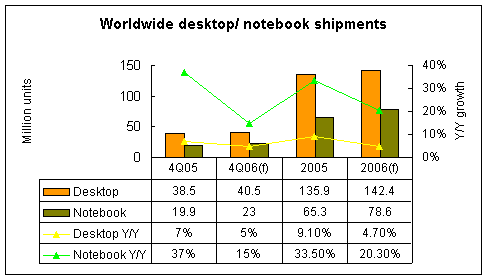bei den älteren Notebook-Prozessoren vom Typ Dothan/Banias (siehe Artikel unten) - und führt zu vorzeitigen Preissenkungen bei Intels Pentium-D-Prozessor-Serie im 3. Quartal um bis zu 67 % (vermutlich für die teuerste "Extreme"-Edition) - was AMD einige Probleme bereiten wird. Intel dürfte dann zweigleisig fahren: Die alten Pentium-D - die nach meiner Erfahrung immer noch schneller sind als die Athlon-64 - werden gegen AMD im Billig-Segment in die Schlacht geschickt, während Neukäufer mit teuren, aber deutlich leistungsfähigeren Conroe- oder Merom-Prozessoren (CORE-Serie) geködert werden, denen AMDs X2-Prozessoren weder preislich (65 nm!) noch leistungsmäßig (siehe Benchmarks oben) das Wasser reichen können.
Vista delay could pull Intel’s price-cut schedule forward
§
David Tzeng, Taipei; Jessie Shen, DigiTimes.com [Thursday 23 March 2006]
Taiwan’s notebook manufacturers expect Intel’s price reduction on dual-core Yonah processors to arrive in advance of the planned date of May 28, with the aim of stimulating the worldwide notebook PC market, despite Microsoft’s delayed launch of its next operating system (OS). Various sources from market research firms, including Lehman Brothers, have pointed out that the delayed release of Microsoft’s consumer-version of its Windows Vista OS will slow notebook demand and push back the peak buying season, the makers noted.
Microsoft, as cited by Toms Hardware,is indicating that the delayed availability of Windows Vista, with the consumer version now slated for release in early 2007, is due to quality concerns, and notably concerns over system security and difficulty on the part of notebook suppliers in following launch and shipment schedules.
The availability of new technologies, including dual-core processors and a 64-bit Windows OS, will be driving up Taiwan’s notebook shipments in 2006, domestic notebook makers earlier estimated. In addition, Intel’s CPU price cuts would further spur worldwide notebook demand, while Taiwan’s contract manufacturers would benefit from increased orders, according to the makers. Affected by Microsoft’s delayed launch of a 64-bit Windows OS, the makers hope that price cuts of up to 67% on Intel’s Pentium D-series CPUs, slated for the third quarter of this year, will be brought forward.
In addition, sources at Taiwan own-brand notebook players consider that seeking strategic alliances with third-generation (3G) service providers is another way to gain competitiveness by emphasizing product differentiation, while the Vista OS is still unavailable for their product offerings. As reported on March 13, Acer will incorporate Vodafone’s 3G connectivity in its upcoming notebook, with availability initially scheduled for this April in Germany, Italy, Spain, France and the UK.
Some PC manufacturers in Taiwan, however, expressed that delayed availability of the consumer version of Vista will help clear the current inventory level, which began rising earlier this year as a result of consumers awaiting Vista-compatible models. The seasonal peak demand of the fourth quarter of the year may, in effect, arrive earlier, in the second and third quarters of this year, as customers change their minds and purchase new models earlier due to uncertainty over a 64-bit OS, indicated the makers.
Today’s Chinese-language Apple Daily cited Topology Research as saying that new versions of Microsoft’s Windows OS now have a smaller impact on the global PC market. In 2005 when the Windows 95 was introduced, worldwide PC shipments grew 32.5%. However, that growth only recorded 23% in 1999, when Windows 2000 arrived. In 2007, the research firm estimates, global PC shipments may only climb 9% on-year, when the Vista OS finally does become available.
A March 22 Lehman Brothers report stated that Microsoft’s delayed launch of a consumer-version Windows Vista will have a negative impact on the global PC market in the fourth quarter of 2006, when shipments are now expected to increase at a slower pace than the on-year growth record during the same period of 2005.
Laut dieser Tabelle, die zu obigem Artikel gehört, dürfte 2006 vor allem der Notebook-Sektor hohe Verkaufszuwächse um 20,3 % zeigen. Das ist gut für Intel, die mit Yonah/Merom in diesem Segment klar die Nase vorn haben. Der Desktop-Sektor hingegen wächst mit 4,7 % nur schleppend - was schlecht für AMD ist, die dort ihren Hauptumsatz erzielen.
|
Angehängte Grafik:
image002.gif
